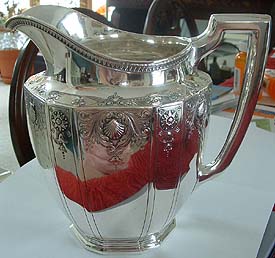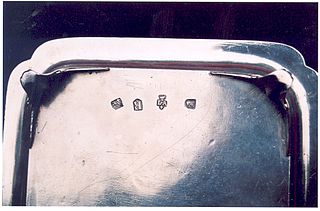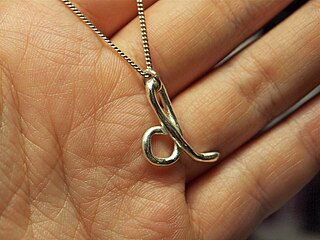Related Research Articles

A coin is a small object, usually round and flat, used primarily as a medium of exchange or legal tender. They are standardized in weight, and produced in large quantities at a mint in order to facilitate trade. They are most often issued by a government. Coins often have images, numerals, or text on them. The faces of coins or medals are sometimes called the obverse and the reverse, referring to the front and back sides, respectively. The obverse of a coin is commonly called heads, because it often depicts the head of a prominent person, and the reverse is known as tails.

The standard circulating coinage of the United Kingdom, British Crown Dependencies and British Overseas Territories is denominated in pennies and pounds sterling, and ranges in value from one penny sterling to two pounds. Since decimalisation, on 15 February 1971, the pound has been divided into 100 (new) pence. Before decimalisation, twelve pence made a shilling, and twenty shillings made a pound.

Sterling silver is an alloy composed by weight of 92.5% silver and 7.5% other metals, usually copper. The sterling silver standard has a minimum millesimal fineness of 925.

The franc, also commonly distinguished as the French franc (FF), was a currency of France. Between 1360 and 1641, it was the name of coins worth 1 livre tournois and it remained in common parlance as a term for this amount of money. It was reintroduced in 1795. After two centuries of inflation, it was redenominated in 1960, with each new franc (NF) being worth 100 old francs. The NF designation was continued for a few years before the currency returned to being simply the franc. Many French residents, though, continued to quote prices of especially expensive items in terms of the old franc, up to and even after the introduction of the euro in 2002. The French franc was a commonly held international reserve currency of reference in the 19th and 20th centuries. Between 1998 and 2002, the conversion of francs to euros was carried out at a rate of 6.55957 francs to 1 euro.

The eagle was a United States $10 gold coin issued by the United States Mint from 1795 to 1933.

In art history, the French term objet d’art describes an ornamental work of art, and the term objets d’art describes a range of works of art, usually small and three-dimensional, made of high-quality materials, and a finely-rendered finish that emphasises the aesthetics of the artefact. Artists create and produce objets d’art in the fields of the decorative arts and metalwork, porcelain and vitreous enamel; figurines, plaquettes, and engraved gems; ivory carvings and semi-precious hardstone carvings; tapestries, antiques, and antiquities; and books with fine bookbinding.

The Coinage Act of 1792, passed by the United States Congress on April 2, 1792, created the United States dollar as the country's standard unit of money, established the United States Mint, and regulated the coinage of the United States. This act established the silver dollar as the unit of money in the United States, declared it to be lawful tender, and created a decimal system for U.S. currency.

A debasement of coinage is the practice of lowering the intrinsic value of coins, especially when used in connection with commodity money, such as gold or silver coins, while continuing to circulate it at face value. A coin is said to be debased if the quantity of gold, silver, copper or nickel in the coin is reduced.

The Canadian five-cent coin, commonly called a nickel, is a coin worth five cents or one-twentieth of a Canadian dollar. It was patterned on the corresponding coin in the neighbouring United States. It became the smallest-valued coin in the currency upon the discontinuation of the penny in 2013. Due to inflation, the purchasing power of the nickel continues to drop and currently the coin represents less than 0.5% of the country's lowest minimum hourly wage.
The fineness of a precious metal object represents the weight of fine metal therein, in proportion to the total weight which includes alloying base metals and any impurities. Alloy metals are added to increase hardness and durability of coins and jewelry, alter colors, decrease the cost per weight, or avoid the cost of high-purity refinement. For example, copper is added to the precious metal silver to make a more durable alloy for use in coins, housewares and jewelry. Coin silver, which was used for making silver coins in the past, contains 90% silver and 10% copper, by mass. Sterling silver contains 92.5% silver and 7.5% of other metals, usually copper, by mass.
A zolotnik was a small Russian unit of weight, equal to 0.1505 avoirdupois ounces, or 4.2658 grams. Used from the 10th to 20th centuries, its name is derived from the Russian word zoloto, meaning gold. As a unit, the zolotnik was the standard for silver manufacture, much as the troy ounce is currently used for gold and other precious metals.

Britannia silver is an alloy of silver containing 11 ozt 10 dwt silver in the pound troy, equivalent to 23⁄24, or 95.833% by weight (mass) silver, the rest usually being copper.

Metal clay is a crafting medium consisting of very small particles of metal such as silver, gold, bronze, or copper mixed with an organic binder and water for use in making jewelry, beads and small sculptures. Originating in Japan in 1990, metal clay can be shaped just like any soft clay, by hand or using molds. After drying, the clay can be fired in a variety of ways such as in a kiln, with a handheld gas torch, or on a gas stove, depending on the type of clay and the metal in it. The binder burns away, leaving the pure sintered metal. Shrinkage of between 8% and 30% occurs. Alloys such as bronze, sterling silver, and steel also are available.

The ruble or rouble is the currency unit of Belarus and Russia. Historically, it was the name of the currency of the Russian Empire and, later, of the Soviet Union.

Silver coins are one of the oldest mass-produced form of coinage. Silver has been used as a coinage metal since the times of the Greeks; their silver drachmas were popular trade coins. The ancient Persians used silver coins between 612–330 BC. Before 1797, British pennies were made of silver.
Crown gold is a 22 karat (kt) gold alloy used in the crown coin introduced in England in 1526. In this alloy, the proportion of gold is 22 parts out of 24. Crown gold is appreciably less prone to wear than the softer 23 kt gold of earlier gold sovereigns — an important point for coins intended for everyday use in circulation.

A silver object that is to be sold commercially is, in most countries, stamped with one or more silver hallmarks indicating the purity of the silver, the mark of the manufacturer or silversmith, and other (optional) markings to indicate date of manufacture and additional information about the piece. In some countries, the testing of silver objects and marking of purity is controlled by a national assayer's office.

The Great Debasement (1544–1551) was a currency debasement policy introduced in 1544 England under the order of Henry VIII which saw the amount of precious metal in gold and silver coins reduced and in some cases replaced entirely with cheaper base metals such as copper. Overspending by Henry VIII to pay for his lavish lifestyle and to fund foreign wars with France and Scotland are cited as reasons for the policy's introduction. The main aim of the policy was to increase revenue for the Crown at the cost of taxpayers through savings in currency production with less bullion being required to mint new coins. During debasement gold standards dropped from the previous standard of 23 karat to as low as 20 karat while silver was reduced from 92.5% sterling silver to just 25%. Revoked in 1551 by Edward VI, the policy's economic effects continued for many years until 1560 when all debased currency was removed from circulation.
The Goldsmiths' Company Assay Office in London is the oldest assay office in the United Kingdom. The company has provided hallmarking services since The Goldsmiths Company was founded in the 14th century. The company received its royal charter in 1327 and ranks fifth in order of precedence of the 12 great livery companies of the City of London.
A Münzfuß is an historical term, used especially in the Holy Roman Empire, for an official minting or coinage standard that determines how many coins of a given type were to be struck from a specified unit of weight of precious metal. The Münzfuß, or Fuß ("foot") for short in numismatics, determined a coin's fineness, i.e. how much of a precious metal it would contain. Mintmaster Julian Eberhard Volckmar Claus defined the standard in his 1753 work, Kurzgefaßte Anleitung zum Probieren und Münzen, as follows: "The appropriate proportion of metals and the weight of the coin, measured according to their internal and external worth, or determined according to their quality, additives and fineness, number and weight, is called the Münzfuß."
References
- ↑ Eddy, C.; Evans, R.; Feld, K. (2015). Beaded Jewelry: Wirework Techniques: Skills, Tools, and Materials for Making Handcrafted Jewelry. A Storey BASICS® Title. Storey Basics. Storey Publishing, LLC. p. 8. ISBN 978-1-61212-485-8 . Retrieved 4 February 2018.
- ↑ "Silver standards". Antiques in Oxford. Retrieved 2020-10-05.
- ↑ Magazine Antiques. Vol. 56. Straight Enterprises, Incorporated. 1949. p. 227.
- 1 2 3 Marina Bowater (31 December 1990). Collecting Russian art & antiques . Hippocrene Books. p. 96. ISBN 978-0-87052-897-2.
- ↑ Haydn Williams; Julia Clarke (31 December 2008). Enamels of the world, 1700–2000: the Khalili collections. Khalili Family Trust. p. 431. ISBN 9781874780175.
- ↑ Institute, Canadian Conservation (2017-09-21). "Understanding how silver objects tarnish". aem. Retrieved 2019-08-27.
- ↑ "Investing In Silver Canadian Coins Pre-1968". www.silverinvestingguide.com. Retrieved 2019-08-27.
- ↑ Anna Somers Cocks; Charles Truman; Sammlung Thyssen-Bornemisza (1984). Renaissance jewels, gold boxes, and objets de vertu. Sotheby Publications. p. 348. ISBN 9780856671722.
- ↑ Anna Somers Cocks; Charles Truman; Sammlung Thyssen-Bornemisza (1984). Renaissance jewels, gold boxes, and objets de vertu. Sotheby Publications. p. 356. ISBN 9780856671722.
- ↑ Dorothy T. Rainwater; Judy Redfield (1 September 1998). Encyclopedia of American silver manufacturers. Schiffer Pub. p. 405. ISBN 978-0-7643-0602-0.
- ↑ CoinWeek (2022-01-18). "Decoplata: The History of .720 Silver in World Coinage". CoinWeek. Retrieved 2022-02-01.